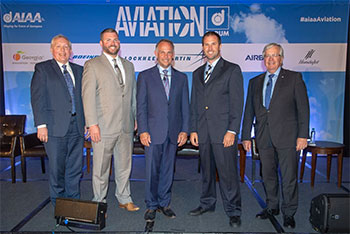Startups Bet on Future of Aviation Written 28 June 2018
Panelists: Moderator John Tylko, chief innovation officer, Aurora Flight Sciences Corp; Andrew Gibson, president, Empirical Systems Aerospace Inc.; Bruce Holmes, vice president of digital aviation, SmartSky Networks LLC; Daniel Morris; director, REaKTOR Business Technology Innovation Center, National Institute of Aerospace; Kevin Noertker, CEO, Ampaire
by Tom Risen, Aerospace America staff reporter (2017-2018)

A group of executives described their strategies for translating technical expertise into entrepreneurship and their views on disruptive new aviation technologies June 26 during the “Inventors and Innovators” panel at the 2018 AIAA AVIATION Forum in Atlanta.
Andrew Gibson, president of Empirical Systems Aerospace Inc., founded the company in 2003 directly after graduation with his fellow graduates from California Polytechnic State University with “no real world experience but also at the time no financial obligations.”
Since founding the company, Gibson and his team have worked on numerous electric aviation projects and are the prime contractor for NASA’s X-57 Maxwell, which is aimed at demonstrating the safety of distributed electric propulsion for passenger travel. Distributed electric propulsion also has the potential to boost urban air mobility with new electric vertical takeoff and landing aircraft, but Gibson is skeptical whether those craft will be available for urban passenger transportation before 2023 because of the challenge of certifying these aircraft for safety.
Gibson said it can be challenging as managers not to accidentally disrupt the innovative process that inevitably ends in failure once in a while.
“A lot of entrepreneurs try to micromanage the process,” Gibson said. “That ends up being its demise.”
Bruce Holmes, the vice president of digital aviation at SmartSky Networks who also spent three decades at NASA, said failure is part of entrepreneurship but that the adventure of running a startup keeps people involved.
“I am on my ninth startup, and five of them have worked,” Holmes said. “I am told by my [venture capital] friends that is a little better than average.”
Recruiting innovative people is a key challenge for startups in part because a small company often cannot compete with the salaries of larger firms. Holmes said one potential solution is to offer equity in the startup with a long-term expectation it will pay off as a potential retirement fund if the company succeeds or is bought by a larger firm.
Startups can also compete for innovative employees by “having a meaningful vision,” said Kevin Noertker, CEO of Ampaire. Noertker co-founded the company in 2016 after seven years at Northrop Grumman with the goal of developing a zero-emission electric plane, the Tail Wind. Keeping diversity in mind when recruiting is important to enable an innovative office culture, Noertker said, adding that some challenges people may not consider are how to avoid biases when writing job descriptions.
“There is a true value having a team with a diverse background,” Noertker said. “It’s not just diversity for the sake of diversity.”
